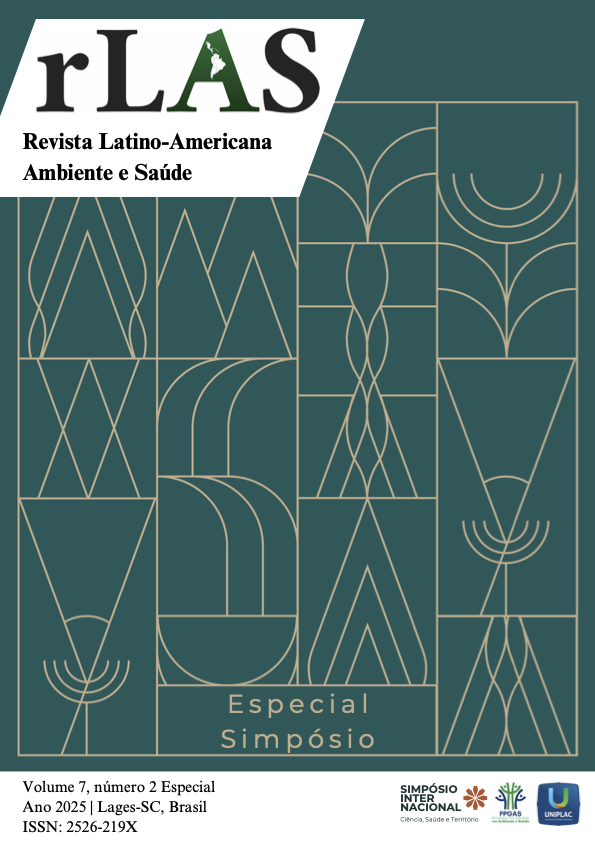Occurrence of multidrug-resistant bacteria in forest soils in Curitibanos - SC
Keywords:
forest soil, thermotolerant coliforms, antimicrobial resistanceAbstract
Antimicrobial resistance is a growing challenge to public health. This study aimed to evaluate the occurrence of multidrug-resistant bacteria in forest soils in the municipality of Curitibanos, SC, Brazil. Soil samples were collected over the course of one year, covering four seasons and various environments such as secondary forest, Pinus and Eucalyptusplantations, agricultural areas, and agroforestry systems. Samples were subjected to serial dilution, cultured on MacConkey agar, and tested for susceptibility to three antibiotics (ampicillin, ciprofloxacin, and tetracycline) using the disk diffusion method. Results showed an overall mean of 2,254,680 CFU g⁻¹ of dry soil, with no statistical difference between sites or seasons. However, antibiotic resistance varied significantly by season, with higher rates observed in autumn and winter. Multidrug-resistant bacteria were mainly found in secondary forest and adult Pinus plantation areas. It is concluded that forest environments may also act as reservoirs of antimicrobial resistance, highlighting the need to include such areas in environmental monitoring programs.
References
ANSELMO, A. P. et al. Bactérias resistentes em alimentos escolares. Revista de Nutrição, Campinas, v. 29, n. 4, p. 519–528, 2016. DOI: 10.1590/1678-98652016000400010.
BAQUERO, F.; MARTÍNEZ, J. L.; CANTÓN, R. Antibiotics and antibiotic resistance in water environments. Current Opinion in Biotechnology, v. 19, n. 3, p. 260–265, 2008. DOI: 10.1016/j.copbio.2008.05.006.
CAUMO, S. et al. Presença de coliformes em fontes utilizadas para irrigação de hortaliças. Revista Brasileira de Engenharia Agrícola e Ambiental, Campina Grande, v. 14, n. 1, p. 85–91, 2010.
CLSI. Clinical and Laboratory Standards Institute. Performance standards for antimicrobial susceptibility testing: twenty-eighth informational supplement M100-S28. Wayne: CLSI, 2018.
COSTA, R. A. et al. Uso de antibióticos e resistência bacteriana. Ciência & Saúde Coletiva, Rio de Janeiro, v. 22, n. 8, p. 2721–2730, 2017. DOI: 10.1590/1413-81232017228.01552017.
CYTRYN, E. The soil resistome: the anthropogenic, the native, and the unknown. Soil Biology and Biochemistry, v. 63, p. 18–23, 2013. DOI: 10.1016/j.soilbio.2013.03.009.
GRAHAM, D. W. et al. Antibiotic resistance gene abundances associated with waste discharges to the environment: a meta-analysis. Environmental Science & Technology, v. 50, n. 14, p. 7740–7749, 2016. DOI: 10.1021/acs.est.6b00288.
JAMIESON, R. et al. Persistence of enteric bacteria in alluvial streams. Water Research, v. 36, n. 10, p. 2653–2662, 2002. DOI: 10.1016/S0043-1354(01)00450-4.
JAMIESON, R. C. et al. Transport and survival of fecal bacteria in agricultural soils. Canadian Journal of Soil Science, Ottawa, v. 82, n. 2, p. 385–395, 2002. DOI: 10.4141/S01-056.
KIRBY, W. M. M.; BAUER, A. W. Antibiotic susceptibility testing by a standardized single disk method. American Journal of Clinical Pathology, v. 45, p. 493–496, 1966.
KRAEMER, S. A. et al. Antibiotic pollution in the environment: from microbial ecology to public policy. Microorganisms, Basel, v. 7, n. 6, p. 180, 2019. DOI: 10.3390/microorganisms7060180.
MARTINS, J. C. et al. Resistência antimicrobiana em bactérias ambientais: uma abordagem de saúde única. Revista Ciência & Saúde, v. 13, n. 1, p. 1–10, 2020.
RIZZO, L. et al. Urban wastewater treatment plants as hotspots for antibiotic resistant bacteria and genes spread into the environment: a review. Science of the Total Environment, v. 447, p. 345–360, 2013. DOI: 10.1016/j.scitotenv.2013.01.032.
TORTORA, G. J.; FUNKE, B. R.; CASE, C. L. Microbiologia. 11. ed. Porto Alegre: Artmed, 2019.
WELLINGTON, E. M. H. et al. The role of the natural environment in the emergence of antibiotic resistance in Gram-negative bacteria. The Lancet Infectious Diseases, v. 13, n. 2, p. 155–165, 2013. DOI: 10.1016/S1473-3099(12)70317-1.
WHO. World Health Organization. Antimicrobial resistance: global report on surveillance. Geneva: WHO, 2014.


